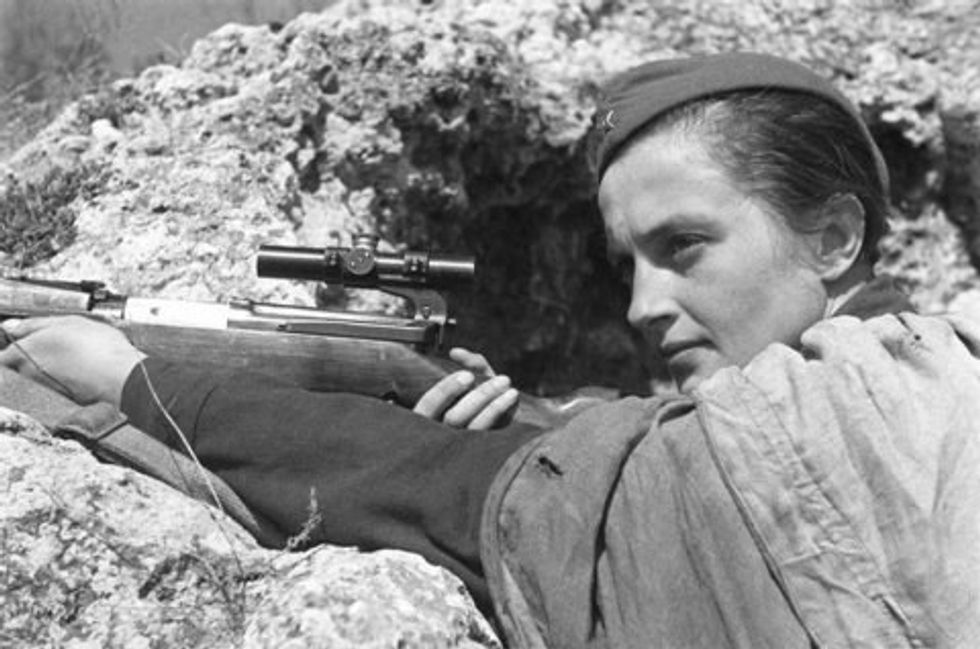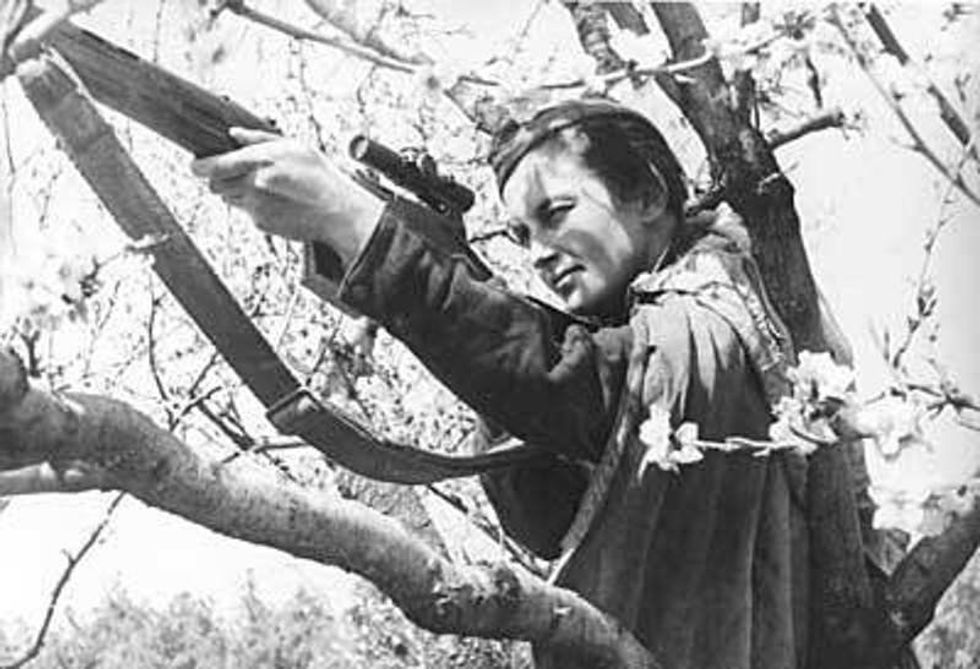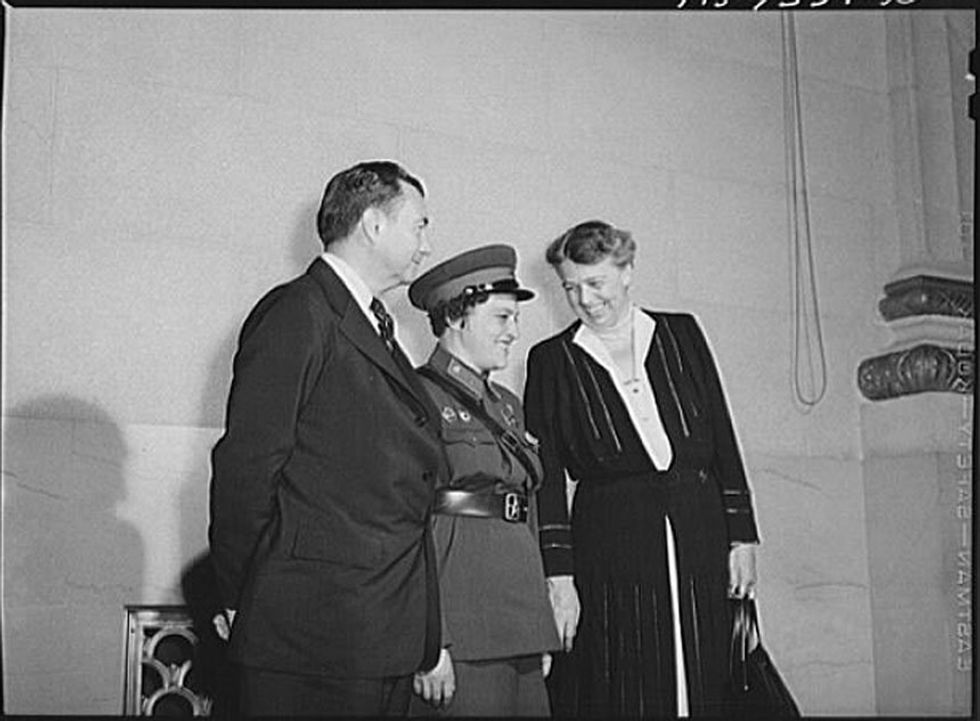Born 12 July, 1916, in Bila Tserkva, Ukraine, Lyudmila Mykhailivna Pavlichenkogrew up to become the deadliest female sniper in all of history (309 confirmed kills!) and earn the title "Hero of the Soviet Union" (the highest distinction in the USSR, akin to the American Medal of Honor). A self-described tomboy, "unruly in the classroom" and unwilling to be outdone by boys "in anything," she moved to Kiev with her family at age fourteen. It was in Kiev that Pavlichenko joined a OSOAVIAKhIM shooting club (a paramilitary sport organization for civilians) and became a certified marksman, earning a Voroshilov Sharpshooter badge among others. Her passion for shooting was kindled by a childhood challenge: "When a neighbor's boy boasted of his exploits at a shooting range, I set out to show that a girl could do as well. So I practiced a lot" (Smithsonian).
Pavlichenko worked hard throughout her young adulthood to increase her skills. For the record, as a teenager she was attending school and working as a metal grinder in a Kiev munitions factory. In 1937 she went to college at Kiev University, studying to become a historian. While at college, Pavilchenko joined their track team for sprinting and pole vaulting, and still "took courses at a sniper's school" on the side (Smithsonian).
It was 22 June, 1941 when Germany invaded the Soviet Union. Pavilchenko was in the first wave of volunteers for infantry. "They wouldn't take girls in the army, so I had to resort to all kinds of tricks to get in," Pavlichenko said later. Despite her many sharpshooting accolades, officials tried to steer her towards nursing. But Pavlichenko managed to nab an audition of sorts with the Red Army. On a hill they were defending, Pavlichenko took a rifle and, when ordered, immediately picked off a pair of Romanians in the distance who were allied with the Germans. (Side note: those two aren't included in Pavlichenko's list of 309 confirmed kills, because – and I quote – "they were test shots" [Smithsonian].) After that, the Red Army eagerly put her in their 25th Chapayev Rifle Division.
Let's stop here for a moment, and remember that despite being arguably the most badass woman of the 20th century, Lyudmila Pavlichenko was also a human being: she faced fear, doubt, and guilt. "I knew that my task was to shoot human beings. In theory that was fine, but I knew that the real thing would be completely different." When she got into position on her first day at the battlefield, Pavlichenko was too afraid to even raise her weapon. Then the young Russian soldier lying in position next to her was shot by a German bullet. "He was such a nice, happy boy. And he was killed just next to me." Witnessing his death gave her the strength to raise her weapon and fight. "After that, nothing could stop me."
And nothing did. Within her first 75 days as a sniper, while fighting in Odessa, Pavlichenko made 187 of her 309 total confirmed kills. That's 2.5 kill shots per day. After the Soviet Union retreated from Odessa, Pavlichenko continued fighting in Moldova, then in Stevastopol for eight months. She dueled with thirty-six snipers, many of whom were highly decorated and lethal, in some of "the tensest experiences" of her life. (You know that someone is a BAMF when they describe facing off with an enemy sniper, in long duels that lasted from overnight to three full days, requiring that she held a position for 15-20 hours just waiting for the enemy to make "one move too many", as "tense.")
By the time she was promoted to sergeant, she had 257 confirmed kills and was cited by the Southern Army War Council for her service. Her response? "I'll get more."
And she did. She became infamous amongst the Germans, who tried to convert her to their side via radio broadcasts, offering everything from an officership to – I kid you not – chocolates. At her refusal, the Germans threatened to tear her into 309 pieces. "They even knew my score!" Pavlichenko later laughed. In only a year, Pavlichenko (now a lieutenant) had made 309 confirmed kills. The word "confirmed" is key: a kill could only be classified as such if it was witnessed by an independent third party. Which means that the real number of people Pavlichenko killed is likely far, far higher than 309.
After taking shrapnel to the face, Pavlichenko was removed from combat. Too famous now for the Soviet Union to risk losing her in battle, Pavlichenko began training young snipers while working as a public spokesman. Soviet High Command sent her to the United States, where they hoped Pavlichenko could garner support for a second front in Europe. This made Pavlichenko the first Soviet citizen to be received at the White House. Eleanor Roosevelt, the First Lady at the time, immediately took a shine to the young sniper. The First Lady invited Pavlichenko to tour America with her, where Pavlichenko would speak about her experiences in combat. The two spoke across America, and developed a friendship that would last for more than 15 years.
During their tour, the American media was baffled that Pavlichenko, a highly decorated sniper and ranking military officer, wasn't wearing any makeup. One reporter criticized the uniform Pavlichenko wore, claiming that it made her look "fat." Reporters asked if she was allowed to wear makeup on the battlefield. Pavlichenko was baffled and frustrated by this. "I wear my uniform with honor. It has the Order of Lenin on it. It has been covered with blood in battle." She challenged American women to fight for their gender equality, and claimed that the American army should follow the Red Army's example in having neither a color line nor segregation. In Chicago, Pavlichenko famously urged the men in the large crowd to support the second front. "I am 25 years old and I have killed 309 fascist occupants by now. Don't you think, gentlemen, that you have been hiding behind my back for too long?"
There was thunderous applause.
Pavlichenko toured Great Britain before returning to Russia. After the war, she completed her education at Kiev University and became a historian. She worked as a research assistant with the Soviet Navy until 1953, then stayed active working for veterans. At age 58, on 10 October, 1974, Lyudmila Pavlichenko – fierce, brave, loyal, eloquent, and very human – died, and was buried in Moscow.























